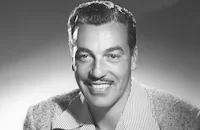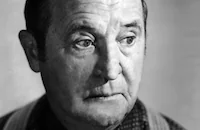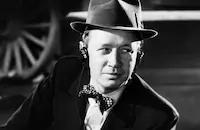The Great American Broadcast
Brief Synopsis
Cast & Crew
Archie Mayo
Alice Faye
Jack Oakie
John Payne
Cesar Romero
James Newill
Film Details
Technical Specs

Synopsis
In 1919, former AEF pilot Rix Martin becomes friends with telephone lineman Chuck Hadley after Chuck aids him in a losing battle to save his airport. Chuck shows Rix his radio equipment and introduces him to his girl friend, singer Vicki Adams. When Chuck expresses his desire to use the radio for entertainment, Rix proposes that they give a concert to interest the public in radio, and that when more receivers are sold as a result, approach the manufacturing companies for a percentage of the profits. When Chuck and Vicki say that they do not have the money for the broadcast, Rix obtains it from millionaire playboy Bruce Chadwick, with whom he served in France. On the night of the broadcast, a rainstorm interferes with their transmission and delays the arrival of their main attraction, opera singer Madame Rinaldi. Their broadcast is a disaster, but Rix does not give up, stating that they need an angle to interest the country in their idea. Rix hits upon a scheme to broadcast the Jess Willard-Jack Dempsey fight that is to take place in Toledo, Ohio on the Fourth of July, and soon all the arrangements are made. While setting up their equipment, Rix comments to Chuck that there should be radio stations every 200 miles that could connect the country coast-to-coast, but Chuck replies that it could not work due to static caused by weather conditions. Rix then goes outside and meets Vicki, and an impulsive kiss prompts them to admit that they love each other. They decide to tell Chuck, who has always had stronger feelings for Vicki than she has had for him, but he sees them kissing and avoids them. Although the broadcast is a huge success, the partnership is disbanded when Chuck punches Rix for stealing Vicki. Chuck and Bruce set up the largest radio station in New York, while Rix and Vicki, after they are married, struggle along with their under-equipped station. Some time later, Bruce offers Vicki a contract to sing at his station, but she declines and convinces him to secretly co-sign a bank loan so that Rix can update their station. When Rix finds out, however, he accuses Vicki of double-crossing him and leaves for South America. A year passes as Vicki becomes the number one attraction of Bruce and Chuck's station, and because she has received no word from Rix, she agrees to divorce him and marry Bruce. Chuck, knowing that Vicki still loves Rix, determines to get him back, and sees his opportunity when he realizes that long-distance telephone lines will enable radio stations to connect coast-to-coast, just as Rix had envisioned. Chuck sends press releases to South America claiming sole responsibility for the idea, and his scheme succeeds in bringing Rix to New York on the night of the first coast-to-coast broadcast. Despite his initial suspicions, Rix is won over when Chuck gives him full credit for the idea on the air. Bruce gracefully bows out when Rix and Vicki are reunited, while Chuck finds romance with his secretary.

Director

Archie Mayo
Cast

Alice Faye

Jack Oakie

John Payne

Cesar Romero
James Newill
The Four Ink Spots
Nicholas Brothers
Wiere Brothers
Mary Beth Hughes
Eula Morgan
William Pawley

Lucien Littlefield
Edward Conrad
Gary Breckner
Mike Frankovich

Frank Orth

Eddie Acuff
Mildred Gover
Syd Saylor
Herbert Heywood

Eddie Kane
Charles Tannen
Cecil Weston
Andre Cuyas
Arno Frey
Al Winter
Dorothy Dearing
Otto Han
Fred "snowflake" Toones
Sam Mcdaniel
Basil Walker
George Dobbs
Edward Smith
Robert Cornell
Herbert Gunn
Kenneth Alexander
John Sinclair
John Collins
Bill Wilkus
Freddie Walburn
Tex Brodus
Bob Brossard
Dick Cherney
Les Clark
Frank Erickson
James Grant
Scotty Hunt
Lee Kass
Frank Lossee
Roland Rego
Bud Cokes
Nora Gale
Patsy Mace
Poppy Wilde
Marion Rosamond
Bunny Hartley
Lillian Eggers
Mary Joyce Walsh
Bettye Avery
Roseanne Murray
Crew
Joseph E. Aiken
Joseph E. Aiken
Travis Banton
Edwin Blum
Harry Brand
Salvatore Cammarano
George M. Cohan
Richard Day
Buddy Desylva
Gaetano Donizetti
Robert Ellis
Don Ettlinger
Mack Gordon
Bud Green
James Havens
Roger Heman
Ray Henderson
Samuel Hoffenstein
Albert Hogsett
Ollie Hughes
Thomas Little
Helen Logan
Kenneth Macgowan
Peverell Marley
Bernard Mceveety
Lillian Myrhe
Alfred Newman
Aaron Rosenberg
Leon Shamroy
Ted Sherdeman
Robert Simpson
Helene Smith
Harry Warren
J. Andrew White
Darryl F. Zanuck

Film Details
Technical Specs

Articles
Fayard Nicholas (1914-2006)
Born on October 20, 1914 in Mobile, Alabama, Fayard was the son of musicians who played in vaudeville pit orchestras. When he was 6 1/2 years of age, his younger brother Harold was born (March 27, 1921, Winston-Salem, North Carolina) and little did they realize that they were destined to be one of the most memorable dance duos in film history.
Fayard learned to dance by watching several vaudeville shows while traveling with his parents. He incorporated many of the acrobatic moves he saw into his own routines, and soon, Harold was learning with him. By 1932, they had auditioned, and landed, a spot in Harlem's celebrated haunt, The Cotton Club. Their routines were a sensation, and Samuel Goldwyn brought them to Hollywood where they performed in Kid Millions (1934) with Eddie Cantor and The Big Broadcast of 1936 (1937). That same year, they appeared on Broadway The Ziegfeld Follies of 1936 and Babes in Arms.
Fayard and Harold headed back to The Cotton Club to polish up their moves, and when they came back to Hollywood in the '40s, they entered their golded period. In Down Argentina Way (1940) starring Don Ameche and Betty Grable, they did that extraordinary number, leaping off a grand piano and doing eye-popping splits over each other on an oversized staircase; Sun Valley Serenade (1941), they have an engaging Chattenooga Choo-Choo routine with a 19-year-old Dorothy Dandridge; and best of all, The Pirate (1948) where they do a terrific Be a Clown routine with Gene Kelly that's every bit as comical as it was inventive.
In the early '50s, the brothers were touring all over the United States and Europe, but in 1957, Harold spent seven years in Paris and only reunited with Fayard in a 1964 television appearance on the hit variety show The Hollywood Palace. But as their performance teaming became less frequent as they got older, Fayard found ways to keep busy. He drew critical praise for his dramatic turn in The Liberation of L.B. Jones (1970) and won a Tony for his choreography for Black and Blue (1989). In 1991, Both Fayard and Harold received the Kennedy Center Honors and most deserved honory Oscars® at the Academy Awards. Nicholas is survived by his wife, Katherine; sister, Dorothy; sons, Tony and Paul; four grandchildren; and a great-granddaughter.
by Michael T. Toole

Fayard Nicholas (1914-2006)
Quotes
Trivia
Notes
Before the film's opening credits, there is a brief montage showing radio personalities Paul Whiteman, Fred Allen, Eddie Cantor, Jack Benny, Kate Smith, Rudy Vallee and Walter Winchell in actual radio situations. According to the Twentieth Century-Fox Records of the Legal Department at the Art-Special Collections Library located at UCLA, Betty Reilly impersonated Kate Smith's voice during the montage. The picture was loosely inspired by the career of radio pioneer Atwater Kent (Dec 1873-April 1949), an American industrialist who was the first inventor to mass produce radio equipment. Inserted during the film is actual sepia-colored footage of the Jack Dempsey-Jess Willard boxing match held on July 4, 1919. The footage was taken by Twentieth Century-Fox from a 1940 two-reel short entitled Birth of a Champion, which chronicled Dempsey's career. According to the Twentieth Century-Fox Produced Scripts Collection, also located at UCLA, the studio originally intended to use footage of Dempsey's 1922 match with Georges Carpentier, which was the first boxing match broadcast on radio, but could not because the film was in "very bad shape." The broadcaster of the Dempsey-Carpentier fight, J. Andrew White, provided Twentieth Century-Fox with historical material about the beginnings of radio, as did Ted Sherdeman, who had been working in radio for fifteen years, but their story suggestions apparently were not used. In discussing the inclusion of the Dempsey-Willard footage, the Variety review stated: "Insertion of the clips is one of the best examples of expert production judgment and editing of the past year." In early 1944, Jess Willard filed suit against Twentieth Century-Fox for including footage of him without his permission, but the disposition of the case has not been determined.
According to Hollywood Reporter news items, Tyrone Power, Betty Grable, Henry Fonda and the Three Oxford Boys were set for the cast at various times, and Twentieth Century-Fox negotiated for W. C. Fields to appear in the picture. Hollywood Reporter also announced that Glenn Miller and his band were to be in the film, but on December 18, 1940 noted that Miller was to be featured instead in Sun Valley Serenade (see below). Los Angeles Times reported on October 14, 1940 that Twentieth Century-Fox was "seeking a band leader star" and to that end had tested Bob Crosby and Skinnay Ennis. Although Hollywood Reporter stated that Fortunio Bonanova was to be included in the cast, his participation in the completed film has not been confirmed. Studio records indicate that Milton Berle was cast in the film and recorded a "radio announcer's routine" for the production, but he is not in the completed picture. Also according to Hollywood Reporter, soundman Joseph E. Aiken was named technical advisor on the picture because of his extensive work in radio, including "the first big public events broadcast in radio history, the election of President Harding in 1920." According to studio publicity materials, the film was to contain a musical number entitled "Run Little Raindrop, Run," written by Mack Gordon and Harry Warren. Hollywood Reporter noted on March 18, 1941 that although all other camera work had been finished on 17 Mar, the number was to be "shot following rehearsals late this week." The song is not included in the finished film, however, and instead was sung by Betty Grable in the 1942 picture Springtime in the Rockies (see below). Studio publicity also lists mock radio ad songs "Chesterstrikes," "Porter's Puppy Biscuits" and "Wavo," which are not included in the completed picture. The legal records note that the scenes of "Rix Martin's" airport were shot at a small airfield in Buena Park, CA. According to an January 11, 1944 memo in the legal records, the studio had thus far made a profit of $81,500 on the picture. The film marked the screen debut of The Four Ink Spots.














